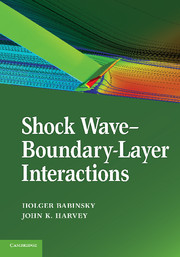Book contents
- Frontmatter
- Brief Contents
- Contents
- Contributors
- 1 Introduction
- 2 Physical Introduction
- 3 Transonic Shock Wave???Boundary-Layer Interactions
- 4 Ideal-Gas Shock Wave???Turbulent Boundary-Layer Interactions (STBLIs) in Supersonic Flows and Their Modeling: Two-Dimensional Interactions
- 5 Ideal-Gas Shock Wave???Turbulent Boundary-Layer Interactions in Supersonic Flows and Their Modeling: Three-Dimensional Interactions
- 6 Experimental Studies of Shock Wave???Boundary-Layer Interactions in Hypersonic Flows
- 7 Numerical Simulation of Hypersonic Shock Wave???Boundary-Layer Interactions
- 8 Shock Wave???Boundary-Layer Interactions Occurring in Hypersonic Flows in the Upper Atmosphere
- 9 Shock-Wave Unsteadiness in Turbulent Shock Boundary-Layer Interactions
- 10 Analytical Treatment of Shock Wave???Boundary-Layer Interactions
- Index
- References
5 - Ideal-Gas Shock Wave???Turbulent Boundary-Layer Interactions in Supersonic Flows and Their Modeling: Three-Dimensional Interactions
Published online by Cambridge University Press: 05 June 2012
- Frontmatter
- Brief Contents
- Contents
- Contributors
- 1 Introduction
- 2 Physical Introduction
- 3 Transonic Shock Wave???Boundary-Layer Interactions
- 4 Ideal-Gas Shock Wave???Turbulent Boundary-Layer Interactions (STBLIs) in Supersonic Flows and Their Modeling: Two-Dimensional Interactions
- 5 Ideal-Gas Shock Wave???Turbulent Boundary-Layer Interactions in Supersonic Flows and Their Modeling: Three-Dimensional Interactions
- 6 Experimental Studies of Shock Wave???Boundary-Layer Interactions in Hypersonic Flows
- 7 Numerical Simulation of Hypersonic Shock Wave???Boundary-Layer Interactions
- 8 Shock Wave???Boundary-Layer Interactions Occurring in Hypersonic Flows in the Upper Atmosphere
- 9 Shock-Wave Unsteadiness in Turbulent Shock Boundary-Layer Interactions
- 10 Analytical Treatment of Shock Wave???Boundary-Layer Interactions
- Index
- References
Summary
Introduction
This chapter continues the description of supersonic turbulent shock wave–boundary layer interactions (STBLIs) by examining the flowfield structure of three-dimensional interactions. The capability of modern computational methods to predict the observed details of these flowfields is discussed for several canonical configurations, and the relationships between them and two-dimensional interactions (see Chapter 4) are explored.
Three-Dimensional Turbulent Interactions
To aid in the understanding of three-dimensional STBLIs, we consider a number of fundamental geometries based on the shape of the shock-wave generator – namely, sharp unswept (Fig. 5.1a) and swept (Fig. 5.1b) fins, semicones (Fig. 5.1c), swept compression ramps (SCRs) (Fig. 5.1d), blunt fins (Fig. 5.1e), and double sharp unswept fins (Fig. 5.1f). More complex three-dimensional shock-wave interactions generally contain elements of one or more of these basic categories. The first four types of shock-wave generators are examples of so-called dimensionless interactions [1] (Fig. 5.1a–d). Here, the shock-wave generator has an overall size sufficiently large compared to the boundary-layer thickness δ that any further increase in size does not affect the flow. The blunt-fin case (Fig. 5.1e) is an example of a dimensional interaction characterized by the additional length scale of the shock-wave generator (i.e., the leading-edge thickness). The crossing swept-shock-wave interaction case (Fig. 5.1f) represents a situation with a more complex three-dimensional flow topology. We briefly discuss the most important physical properties of these three-dimensional flows and provide examples of numerical simulations.
Information
- Type
- Chapter
- Information
- Shock Wave-Boundary-Layer Interactions , pp. 202 - 258Publisher: Cambridge University PressPrint publication year: 2011
References
Accessibility standard: Unknown
Why this information is here
This section outlines the accessibility features of this content - including support for screen readers, full keyboard navigation and high-contrast display options. This may not be relevant for you.Accessibility Information
- 23
- Cited by
